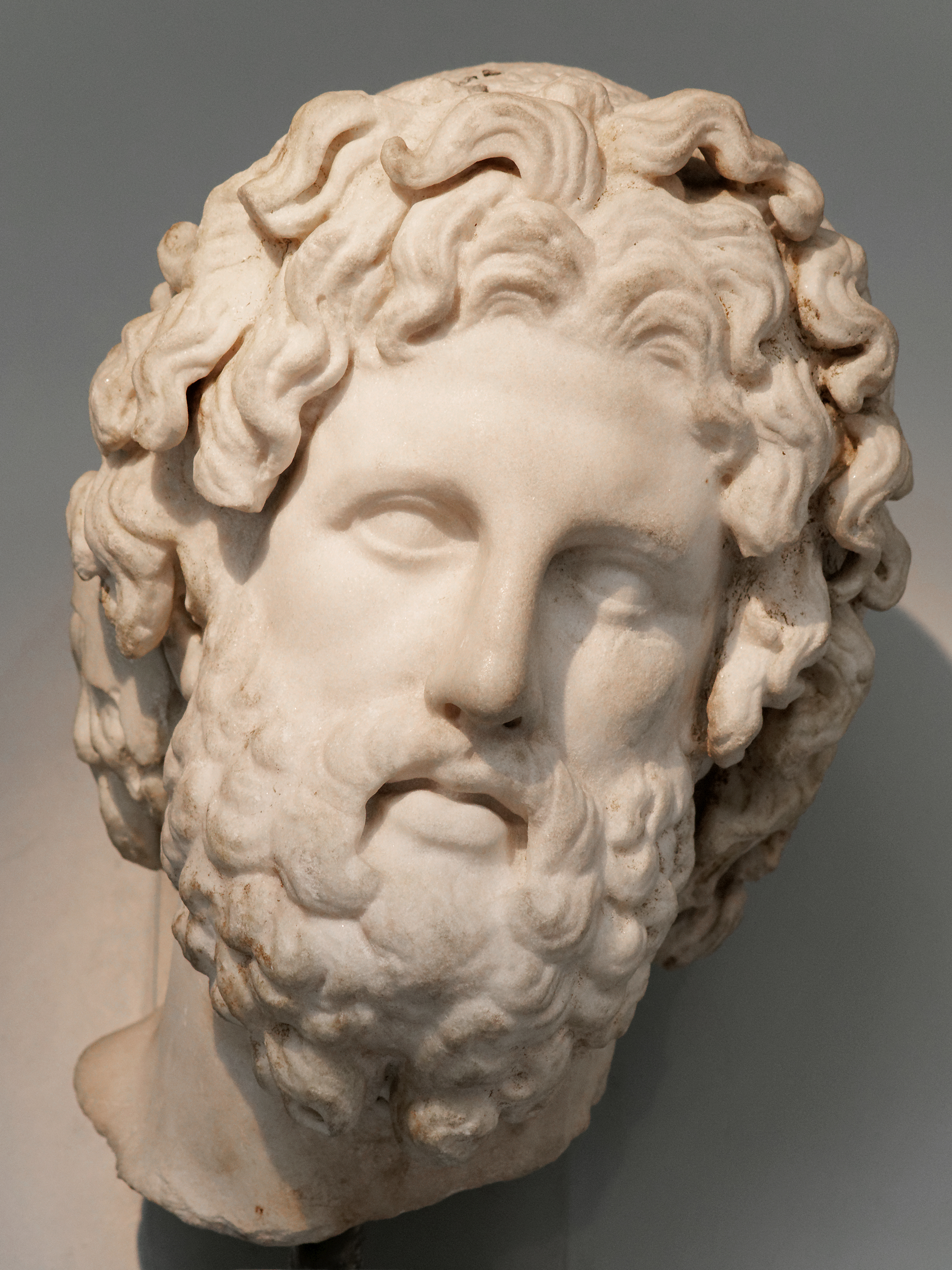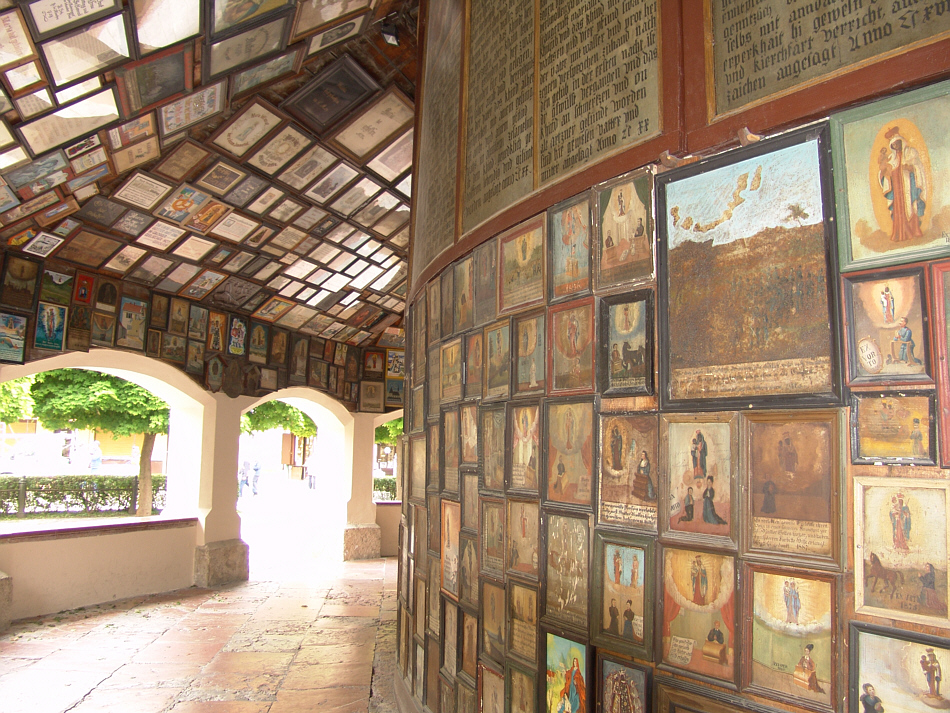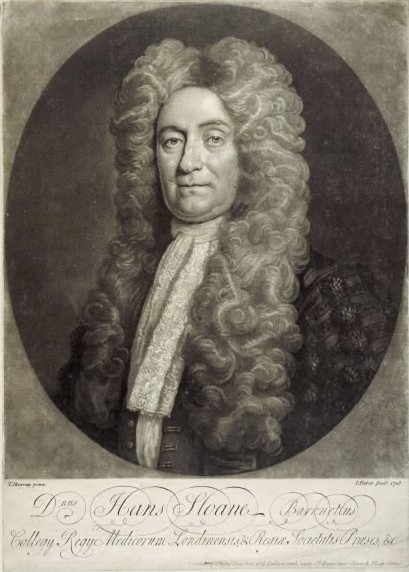|
Asclepius Of Milos
The Asclepius of Milos or Asklepios of Melos is a marble head from what was once a colossal ancient Greek statue of Asclepius found on the island of Milos in Greece. It was acquired by the British Museum along with the rest of the Blacas collection in 1867. Discovery The head was found in the mid nineteenth century at the shrine of Asclepius on the island of Milos in the Cyclades, Greece. It was later acquired by the French diplomat and collector Louis, Duke of Blacas. The Blacas collection was purchased in its entirety by the British Museum in 1867. Description The head is made from Parian marble and was once part of a twice life-size cult statue of the ancient Greek god of medicine and healing Asclepius (or Asklepios). It was made from three pieces, only two of which are extant. Around the head are drill holes and lead pegs for a now missing gold wreath that once crowned the statue. The serene expression on the deity's face is typical of Hellenistic sculpture from this period. ... [...More Info...] [...Related Items...] OR: [Wikipedia] [Google] [Baidu] |
Asklepios Melos BM Sc550
Asclepius (; grc-gre, Ἀσκληπιός ''Asklēpiós'' ; la, Aesculapius) is a hero and god of medicine in ancient Greek religion and mythology. He is the son of Apollo and Coronis, or Arsinoe, or of Apollo alone. Asclepius represents the healing aspect of the medical arts; his daughters, the "Asclepiades", are: Hygieia ("Health, Healthiness"), Iaso (from ἴασις "healing, recovering, recuperation", the goddess of recuperation from illness), Aceso (from ἄκεσις "healing", the goddess of the healing process), Aegle (the goddess of good health) and Panacea (the goddess of universal remedy). He has several sons as well. He was associated with the Roman/Etruscan god Vediovis and the Egyptian Imhotep. He shared with Apollo the epithet ''Paean'' ("the Healer"). The rod of Asclepius, a snake-entwined staff, (similar to the caduceus) remains a symbol of medicine today. Those physicians and attendants who served this god were known as the Therapeutae of Asclepius. ... [...More Info...] [...Related Items...] OR: [Wikipedia] [Google] [Baidu] |
Staff Of Asclepius
In Greek mythology, the Rod of Asclepius (⚕; grc, Ράβδος του Ασκληπιού, , sometimes also spelled Asklepios), also known as the Staff of Aesculapius and as the asklepian, is a serpent-entwined rod wielded by the Greek god Asclepius, a deity associated with healing and medicine. Theories have been proposed about the Greek origin of the symbol and its implications. In modern times, it is the predominant symbol for medicine and health care, although, because of a misunderstanding concerning ⚕ and ☤, the Caduceus (the symbol of commerce) is sometimes seen in this context, although both rods, from which these symbols represent, were each given to Asclepius and to Hermes by Apollo. Greek mythology and Greek society The Rod of Asclepius takes its name from the Greek god Asclepius, a deity associated with healing and medicinal arts in ancient Greek religion and mythology. Asclepius' attributes, the snake and the staff, sometimes depicted separately in antiq ... [...More Info...] [...Related Items...] OR: [Wikipedia] [Google] [Baidu] |
Marble Sculptures In The United Kingdom
Marble is a metamorphic rock composed of recrystallized carbonate minerals, most commonly calcite or dolomite. Marble is typically not foliated (layered), although there are exceptions. In geology, the term ''marble'' refers to metamorphosed limestone, but its use in stonemasonry more broadly encompasses unmetamorphosed limestone. Marble is commonly used for sculpture and as a building material. Etymology The word "marble" derives from the Ancient Greek (), from (), "crystalline rock, shining stone", perhaps from the verb (), "to flash, sparkle, gleam"; R. S. P. Beekes has suggested that a " Pre-Greek origin is probable". This stem is also the ancestor of the English word "marmoreal," meaning "marble-like." While the English term "marble" resembles the French , most other European languages (with words like "marmoreal") more closely resemble the original Ancient Greek. Physical origins Marble is a rock resulting from metamorphism of sedimentary carbonate rocks, most ... [...More Info...] [...Related Items...] OR: [Wikipedia] [Google] [Baidu] |
Statues
A statue is a free-standing sculpture in which the realistic, full-length figures of persons or animals are carved or cast in a durable material such as wood, metal or stone. Typical statues are life-sized or close to life-size; a sculpture that represents persons or animals in full figure but that is small enough to lift and carry is a statuette or figurine, whilst one more than twice life-size is a colossal statue. Statues have been produced in many cultures from prehistory to the present; the oldest-known statue dating to about 30,000 years ago. Statues represent many different people and animals, real and mythical. Many statues are placed in public places as public art. The world's tallest statue, ''Statue of Unity'', is tall and is located near the Narmada dam in Gujarat, India. Color Ancient statues often show the bare surface of the material of which they are made. For example, many people associate Greek classical art with white marble sculpture, but there is evidenc ... [...More Info...] [...Related Items...] OR: [Wikipedia] [Google] [Baidu] |
Ancient Greek And Roman Sculptures In The British Museum
Ancient history is a time period from the beginning of writing and recorded human history to as far as late antiquity. The span of recorded history is roughly 5,000 years, beginning with the Sumerian cuneiform script. Ancient history covers all continents inhabited by humans in the period 3000 BCAD 500. The three-age system periodizes ancient history into the Stone Age, the Bronze Age, and the Iron Age, with recorded history generally considered to begin with the Bronze Age. The start and end of the three ages varies between world regions. In many regions the Bronze Age is generally considered to begin a few centuries prior to 3000 BC, while the end of the Iron Age varies from the early first millennium BC in some regions to the late first millennium AD in others. During the time period of ancient history, the world population was already exponentially increasing due to the Neolithic Revolution, which was in full progress. While in 10,000 BC, the world population stood ... [...More Info...] [...Related Items...] OR: [Wikipedia] [Google] [Baidu] |
The British Museum Press
The British Museum is a public museum dedicated to human history, art and culture located in the Bloomsbury area of London. Its permanent collection of eight million works is among the largest and most comprehensive in existence. It documents the story of human culture from its beginnings to the present.Among the national museums in London, sculpture and decorative and applied art are in the Victoria and Albert Museum; the British Museum houses earlier art, non-Western art, prints and drawings. The National Gallery holds the national collection of Western European art to about 1900, while art of the 20th century on is at Tate Modern. Tate Britain holds British Art from 1500 onwards. Books, manuscripts and many works on paper are in the British Library. There are significant overlaps between the coverage of the various collections. The British Museum was the first public national museum to cover all fields of knowledge. The museum was established in 1753, largely based o ... [...More Info...] [...Related Items...] OR: [Wikipedia] [Google] [Baidu] |
Votive Relief Asklepios BM809
A votive offering or votive deposit is one or more objects displayed or deposited, without the intention of recovery or use, in a sacred place for religious purposes. Such items are a feature of modern and ancient societies and are generally made in order to gain favor with supernatural forces. While some offerings were apparently made in anticipation of the achievement of a particular wish, in Western cultures from which documentary evidence survives it was more typical to wait until the wish has been fulfilled before making the offering, for which the more specific term ex-voto may be used. Other offerings were very likely regarded just as gifts to the deity, not linked to any particular need. In Buddhism, votive offering such as construction of stupas was a prevalent practice in Ancient India, an example of which can be observed in the ruins of the ancient Vikramshila University and other contemporary structures. Votive offerings have been described in historical Roman er ... [...More Info...] [...Related Items...] OR: [Wikipedia] [Google] [Baidu] |
Asklepios
Asclepius (; grc-gre, Ἀσκληπιός ''Asklēpiós'' ; la, Aesculapius) is a hero and god of medicine in ancient Religion in ancient Greece, Greek religion and Greek mythology, mythology. He is the son of Apollo and Coronis (lover of Apollo), Coronis, or Arsinoe (Greek myth), Arsinoe, or of Apollo alone. Asclepius represents the healing aspect of the medical arts; his daughters, the "Asclepiades", are: Hygieia ("Health, Healthiness"), Iaso (from ἴασις "healing, recovering, recuperation", the goddess of recuperation from illness), Aceso (from ἄκεσις "healing", the goddess of the healing process), Aegle (mythology), Aegle (the goddess of good health) and Panacea (the goddess of universal remedy). He has several sons as well. He was associated with the Roman/Etruscan god Vediovis and the Egyptian Imhotep. He shared with Apollo the epithet ''Paean'' ("the Healer"). The rod of Asclepius, a snake-entwined staff, (similar to the caduceus) remains a symbol of medi ... [...More Info...] [...Related Items...] OR: [Wikipedia] [Google] [Baidu] |
Serpent (symbolism)
The serpent, or snake, is one of the oldest and most widespread mythological symbols. The word is derived from Latin ''serpens'', a crawling animal or snake. Snakes have been associated with some of the oldest rituals known to mankind and represent dual expression of good and evil. In some cultures, snakes were fertility symbols. For example, the Hopi people of North America performed an annual snake dance to celebrate the union of Snake Youth (a Sky spirit) and Snake Girl (an Underworld spirit) and to renew the fertility of Nature. During the dance, live snakes were handled, and at the end of the dance the snakes were released into the fields to guarantee good crops. "The snake dance is a prayer to the spirits of the clouds, the thunder and the lightning, that the rain may fall on the growing crops." To the Hopi, snakes symbolized the umbilical cord, joining all humans to Mother Earth. The Great Goddess often had snakes as her familiars—sometimes twining around her sacred staff ... [...More Info...] [...Related Items...] OR: [Wikipedia] [Google] [Baidu] |
Hellenistic Sculpture
Hellenistic sculpture represents one of the most important expressions of Hellenistic culture, and the final stage in the evolution of Ancient Greek sculpture. The definition of its chronological duration, as well as its characteristics and meaning, have been the subject of much discussion among art historians, and it seems that a consensus is far from being reached. The Hellenistic period is usually considered to comprise the interval between the death of Alexander the Great in 323 BC, and the conquest of Egypt by the Romans in 30 BC. Its generic characteristics are defined by eclecticism, secularism, and historicism, building on the heritage of classical Greek sculpture and assimilating Eastern influences. Among his original contributions to the Greek tradition of sculpture were the development of new techniques, the refinement of the representation of human anatomy and emotional expression, and a change in the goals and approaches to art, abandoning the generic for the specific. ... [...More Info...] [...Related Items...] OR: [Wikipedia] [Google] [Baidu] |
British Museum
The British Museum is a public museum dedicated to human history, art and culture located in the Bloomsbury area of London. Its permanent collection of eight million works is among the largest and most comprehensive in existence. It documents the story of human culture from its beginnings to the present.Among the national museums in London, sculpture and decorative and applied art are in the Victoria and Albert Museum; the British Museum houses earlier art, non-Western art, prints and drawings. The National Gallery holds the national collection of Western European art to about 1900, while art of the 20th century on is at Tate Modern. Tate Britain holds British Art from 1500 onwards. Books, manuscripts and many works on paper are in the British Library. There are significant overlaps between the coverage of the various collections. The British Museum was the first public national museum to cover all fields of knowledge. The museum was established in 1753, largely b ... [...More Info...] [...Related Items...] OR: [Wikipedia] [Google] [Baidu] |
Wreath
A wreath () is an assortment of flowers, leaves, fruits, twigs, or various materials that is constructed to form a circle . In English-speaking countries, wreaths are used typically as household ornaments, most commonly as an Advent and Christmas decoration. They are also used in ceremonial events in many cultures around the globe. They can be worn as a chaplet around the head, or as a garland around the neck. Etymology The word ''wreath'' comes from Middle English ''wrethe'' and from Old English ''writha'' 'band'. History Ancient Etruscan wreaths Wreaths were a design used in ancient times in southern Europe. The most well-known are pieces of Etruscan civilization jewelry, made of gold or other precious metals. Symbols from Greek myths often appear in the designs, embossed in precious metal at the ends of the wreath. Ancient Roman writers referred to Etruscan ''corona sutilis'', which were wreaths with their leaves sewn onto a background. These wreaths resemble a ... [...More Info...] [...Related Items...] OR: [Wikipedia] [Google] [Baidu] |










